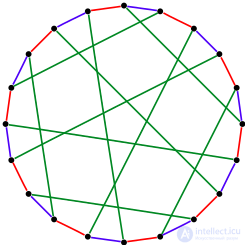Lecture
The chromatic number of the graph G is the minimum number of colors in which you can color the vertices of the graph G so that the ends of any edge have different colors. Denoted by χ ( G ).
Chromatic number of the graph - the minimum number  such a lot
such a lot  vertices of the graph can be divided into
vertices of the graph can be divided into  disjoint classes
disjoint classes  :
:

such that the vertices in each class are independent, that is, any edge of the graph does not connect the vertices of the same class.
 . That is, its vertices can be painted
. That is, its vertices can be painted  different colors so that any edges will have different colors.
different colors so that any edges will have different colors. . That is, the vertices of the graph can be painted
. That is, the vertices of the graph can be painted  colors so that at any edge the ends will be of different colors, but so color
colors so that at any edge the ends will be of different colors, but so color  Flowers - no longer possible.
Flowers - no longer possible. 
графа Дезарга.
line coloring cubic graph
The chromatic class of the graph G is the minimum number of colors in which the edges of the graph G can be colored so that the adjacent edges have different colors. Denoted by χ '( G ). The problem of edge coloring of an arbitrary flat cubic graph without bridges in three colors is equivalent to the famous Problem of four colors. The edge coloring determines the 1-factorization of the graph.
If we consider the number of different colorings of the labeled graph as a function of the available number of colors t , then it turns out that this function will always be a polynomial in t . This fact was discovered by Birkhoff and Lewis [1] while trying to prove the hypothesis of four colors.
Triangle  |
 |
Complete graph  |
 |
Tree with  tops tops |
 |
Cycle  |
 |
| Count Petersen |  |
For a vertex graph, the chromatic polynomial is 

The chromatic polynomial of a graph is equal to the product of chromatic polynomials of its components.

There is also a recurrence relation.

Where  and
and  - adjacent vertices,
- adjacent vertices,  - graph resulting from graph
- graph resulting from graph  by removing the edge
by removing the edge  but
but  - graph resulting from graph
- graph resulting from graph  by tightening the rib
by tightening the rib  exactly.
exactly.
You can use the equivalent formula

Where  and
and  - non-adjacent vertices, and
- non-adjacent vertices, and  - graph resulting from graph
- graph resulting from graph  by adding an edge
by adding an edge 
For all positive integers 

Chromatic number  - the smallest positive integer
- the smallest positive integer  , for which
, for which

Also, the chromatic number can be considered for other objects, for example, for metric spaces. Thus, the chromatic number of a plane is the minimum number of colors χ for which there exists such a coloring of all points of the plane into one of the colors that no two points of the same color are exactly 1 apart from each other. Similarly for any dimension of space. It is elementarily proved that for a plane  however, it is still not possible to advance further. This task is called the Nelson – Erdёs – Hadwiger problem.
however, it is still not possible to advance further. This task is called the Nelson – Erdёs – Hadwiger problem.
Many deep problems of graph theory are easily formulated in terms of coloring. The most famous of these problems, the problem of four colors, has now been solved, but new ones are emerging, for example, a generalization of the problem of four colors, the Hadwiger hypothesis.
Comments
To leave a comment
Discrete Math. Set theory. Graph theory. Combinatorics.
Terms: Discrete Math. Set theory. Graph theory. Combinatorics.